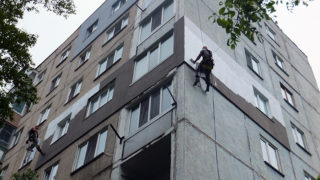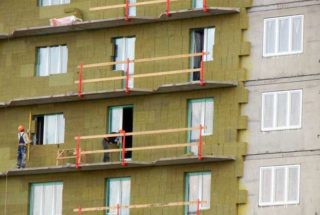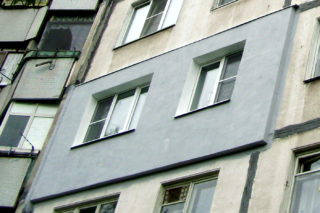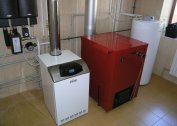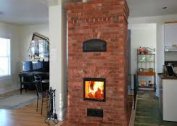Freezing walls in prefabricated houses in winter is a common problem that must be solved with the help of high-quality insulation. The reason may be poor ventilation, interruptions in heating, or mistakes made during construction. For the insulation of such walls, various types of insulation and methods are used, each of which has its own characteristics, advantages and disadvantages.
The reasons for the freezing of panel walls
Most often, the walls freeze due to the accumulation of a large amount of moisture, due to which the cold easily penetrates into the rooms. In addition, the list of the most common causes includes:
- lack of adequate ventilation, causing the formation of moisture;
- problems with heating, because of which the walls in the house do not have time to warm up and dry out;
- mistakes made during construction, for example, poor sealing of cracks between panels;
- poor or poor-quality waterproofing, most often this problem occurs in rooms located on the upper floors;
- the need for major repairs in the house when deep cracks appear between the panels.
Any insulation of the external wall of the panel house and its facade can be carried out only after the exact determination of the source of the problem. Most often, several factors provoke it at once.
Advantages and disadvantages of insulation
High-quality external wall insulation helps to eliminate the main problems with thermal insulation and stabilize the temperature inside the room, where it will become cool in summer and warm in winter. External materials reduce the cost of heating and cooling rooms, help to eliminate moisture removal, which causes peeling of wallpaper and sprinkling of paint, the appearance of dampness, fungi and mold. Insulated walls absorb more extraneous noise and will look more respectable. With external insulation, the area of the space will not decrease, unlike the option of insulation from the inside.
The disadvantages of the procedure are primarily associated with the features of the materials used and non-compliance with the rules of the work. The main disadvantage is the inability to carry out work at any time of the year. Certain conditions must be observed: the outside temperature should fluctuate within 5-20 degrees of heat, humidity should not be lower than 60%. Work is best done in hot weather, the procedure is not suitable for winter. Also, at the time of the street there should not be strong wind and rainfall.
Materials for thermal insulation
A large number of heaters are presented on the market of thermal insulation materials. For panel walls, it is better to choose mineral wool or expanded polystyrene. Each of the insulation has its own advantages and disadvantages.
Mineral wool
Mineral or stone wool is a material based on extruded stone chips. Due to the use of stone, mineral wool slabs have stable walls and are 90% filled with air inside. To warm any prefabricated house from the outside, use basalt, mineral or glass wool. Basalt material is considered the most popular due to the ease of installation, low cost and optimal thermal insulation performance.It is rarely used for facade houses, since such installation requires the creation of an additional frame.
Glass wool is used much less often due to low thermal insulation properties and difficulties at all stages of installation. To work with this material, specialists require special protection and safety precautions. Mineral cellulose wool is a heater made from foamed paper residues. It is quite flammable, but this material is considered the most environmentally friendly, although it does not fully cope with its basic functions.
Expanded polystyrene
Expanded polystyrene is considered the most popular option for insulation of facades in Russia. Its main advantage is that it is absolutely not affected by water compared to mineral wool boards, which over time completely lose their properties due to moisture inside.
Minvata is capable of serving no more than 10 years, while the term of operation of expanded polystyrene is at least 30-50 years.
Sheets of this material are fixed on the facades using special glue or dowels, or both of these methods are combined for reliability.
Methods of insulation of the external wall of a panel house
The external walls of prefabricated houses can be insulated using two installation methods: dry or ventilated and wet. Each of the technologies has its own characteristics and advantages, which are worth considering separately.
Dry
With the dry method, you can not use mixtures with the addition of water. To create a layer of thermal insulation using this technique, a layer is made of heat insulation materials that are closed with shield materials. Ready-made facades are called ventilated, since an air gap must be left between the insulation and panel material for the purpose of full ventilation. It is possible to warm a house in this way with minimal financial costs, especially if you choose the most economical materials, for example, polystyrene foam.
Wet
The wet method allows you to insulate the surface of the facade with the help of special mixtures having a water base, the composition of which can be different. Most often they use a special foamed insulation containing cellulose. The main advantage of this method is the ability to fill all holes and slots. Thanks to the wet method, cold bridges do not appear in the walls, causing heat to leak from the room.
Work sequence
Regardless of the technology chosen, walls must be prepared before starting work. You can start them only after making calculations and purchasing all the necessary materials. During the purchase, they are guided by the overall plan of the building and the place for fasteners. In addition to the main insulation, sealant and auxiliary elements are additionally purchased, including building materials: scaffolding for high-altitude work, spatulas for sealing, a drill and safety cables. At the stage of preparing the walls, the old coating is removed, the joints are coated with putty and all the cracks are closed. Insulation can be mounted only on flat and clean walls.
Installation of expanded polystyrene sheets is carried out in stages, after applying glue to the walls. After gluing all the plates, they are additionally fixed with dowels. At the preparation stage, it is important to seal the joints between the panels. For this purpose, bayonets are opened, the seams are cleaned of old materials, a substrate is prepared for new ones, then heat insulation tubes are installed and covered with foam.
Some materials, such as polystyrene foam, need reinforcement and subsequent priming.At the final stage, the surfaces are covered with plaster and paint of the desired shade, this coating helps to hide the joints between the panels and create a cosmetic effect.
The plaster must be coated with waterproof paints, if possible, you can use a special warming paint. The most difficult areas are windows and corners, which need to be insulated according to special rules. A sealant is used to warm the corners, window openings will need to be equipped with high-quality double-glazed windows, the end parts are covered with expanded polystyrene, foam or foam plastic plates with subsequent reinforcement. The facade should look uniform at the final stage of decoration.
If the walls are uneven, they can be leveled with glue, but with a maximum of 2 cm. In the presence of large distortions, more expensive methods are chosen.

